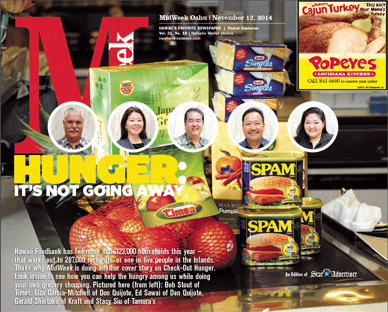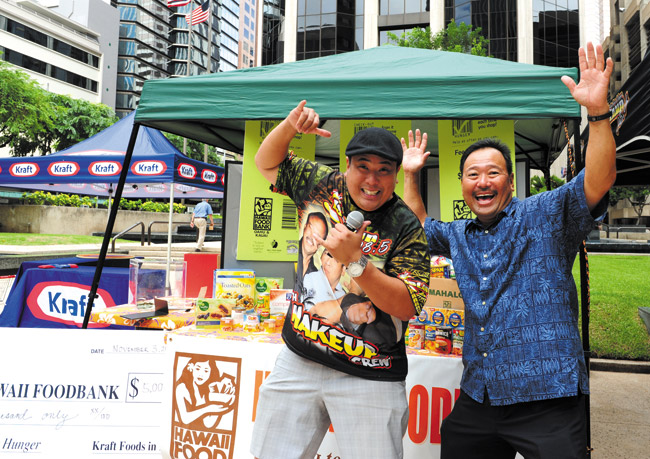Hunger: It’s Not Going Away
Hawaii Foodbank has fed more than 123,000 households this year — that works out to 287,000 residents, or one in five people in the Islands. That’s why MidWeek is doing another cover story on Check-Out Hunger. Read on to see how you can help the many hungry among us while doing your own grocery shopping
You have read this story before.
Heck, you have read this author’s rendition of it three times in as many years.
Check-Out Hunger is as much a part of our Christmas season as Shaka Santa, palm trees festooned with string lights and the Hawaii Bowl.
And that’s the problem — the people of our Islands going to bed hungry has become … well, kinda banal.
“There really is no twist, the need continues,” says Gerald Shintaku of Kraft Foods, a sponsor of this event for more than a decade. “The twist would be if we get this thing knocked out one day — I think we are still far from it — but unfortunately that is still the boring story. The need continues and we are trying our best to help.”
In fact, the need has grown. According to Hunger in America 2014, which is the most comprehensive study ever done on domestic hunger-relief efforts, Hawaii Foodbank fed more than 123,000 households this year, encompassing 287,000 residents, or one in five people living in our state.
“The people we serve look at the food bank as not only an emergency supplier for them, but that we are how they survive, and they are planning on using the food bank for a while,” says Polly Kauahi, vice president and COO of Hawaii Foodbank.
“When you think about a senior citizen, what other choice do they have? They are on a fixed income; they get their food stamps and Social Security; they cannot go out and get a job. So the people who need our services are going to need them for a long time. It is a part of the graying of Hawaii.”
Currently, there are 46,000 kupuna and 48,000 keiki whom the food bank is assisting, and for families helping the very young and the very old, there are difficult decisions to make.
The study details these tough choices that residents are forced into, such as: 62 percent of Hawaii Foodbank clients have to choose between paying utilities or buying food, and 52 percent who make that same choice between feeding their families and paying the rent.
Fortunately, our Islands are a giving place, and when we know our neighbors are in need, we do all we can on our own strained budgets to help.
“It’s local based, it is poor people in Hawaii, a group that is very much in need,” says James Starshak, a partner in the law firm Carlsmith Ball who first began helping at Hawaii Foodbank 15 years ago and now serves as secretary of its board. “People see that warehouse out there get empty, it is startling to see. One day it is full, the next day there is nothing.”
This constant ebb and flow of food is the heartbeat of the food bank, but when supplies begin to run low, that pulse runs a little faster as it looks to keep the lifeblood of so many families pumping. It currently has less than a two-week supply, and when you have almost 300,000 people counting on you for dinner, one would appreciate a little more cushion.
“The holidays are a natural time of giving, and we are hoping to use it to help fill up our shelves,” says Kauahi, who understands that things are tight for almost everyone.
“Before they could donate to us a Costco six-pack of cans. Not so many of those six-packs coming in anymore. They are using some of those for their families and donating the rest. The same budget stretches that are happening on family budgets are happening at the food bank.”
When giving to a charity, it is important for you to know that your money is going to actually help and not line the pockets of an administrator or be eaten up by unnecessary overhead. Starshak describes Dick Grimm, CEO of Hawaii Foodbank, as the most under-paid charity leader in the state, and as for overhead, Hawaii Foodbank boasts a 95 percent return-on-investment.
“One of the biggest reasons I support the food bank is the percentages that go back to people who need,” says Bob Stout, president of Times Supermarket, longtime participant in the Check-Out Hunger program. “There are a lot of big charities I could name, and you are lucky if you get to 60 percent. These guys are in the mid-90s.
“Plus, it is a natural fit for us because we are grocers. The impact that it has, the number of people who are using the food bank in relation to the number of people in the state, it is way too many people. At Times we are big about being a good corporate citizen, and Hawaii Foodbank is our No. 1 cause.”
Starting last week, you could look for those iconic fluorescent green tags in the Times, Tamura’s, Safeway and Don Quijote checkout lanes, with donation levels ranging from $2.81 to feed a child breakfast for a week, $12.43 to feed a senior lunch for a month and $16.84 to feed a family dinner for a week.
Each island’s donations will stay on that island to help those in need there. For instance, if you shop at the Kauai Times Supermarket, all of your donation will go to Kauai Food Bank.
The program has raised more than $2 million during its 20-year run, with $219,000 brought in last year alone. The need for funds has grown for more reasons than just the burgeoning population of needy citizens.
A decade ago, Hawaii Foodbank purchased only 2 percent of the food it used to feed the hungry. Last year, that number grew to 21 percent.
“Food prices going up hurts our ability to buy food, as well as the amount of food people can donate,” says Kauahi, noting the recent rise in the cost of rice from $6,000 a container to now more than $14,000.
The program will run through the holidays, wrapping up Jan. 16, and hope is it can surpass last year’s donation levels with the increased need and cost for food. Kraft Foods kicked off the event with a $5,000 donation, but Shintaku was quick to stress the credit for the event’s success lies with the retailers and the citizens of Hawaii: “The thing to emphasize is that, if it wasn’t for the supermarkets — the Safeways, Times and Don Quijotes — that continue to support this program, then this really wouldn’t happen.
“The action actually happens in the stores. Customers come in, shop multiple times a week. What better place to give than right there at the check stand? Just pull off one of those bright green coupons and add it to your grocery bill. It’s simple!”
So there is the story, once again: Our people are hungry and it is up to us to help feed them. Tear off a green chit and make a difference. Every little bit helps, but even if you cannot, the volunteers and supporters of Hawaii Foodbank will keep at it until this crisis is averted.
“The need is still there,” notes Shintaku. “This is our 11th year, and once the hunger is done, then we will be done. So we hope we are working toward that. But, for now, it is the same program and we are looking for everybody’s support on this.”







